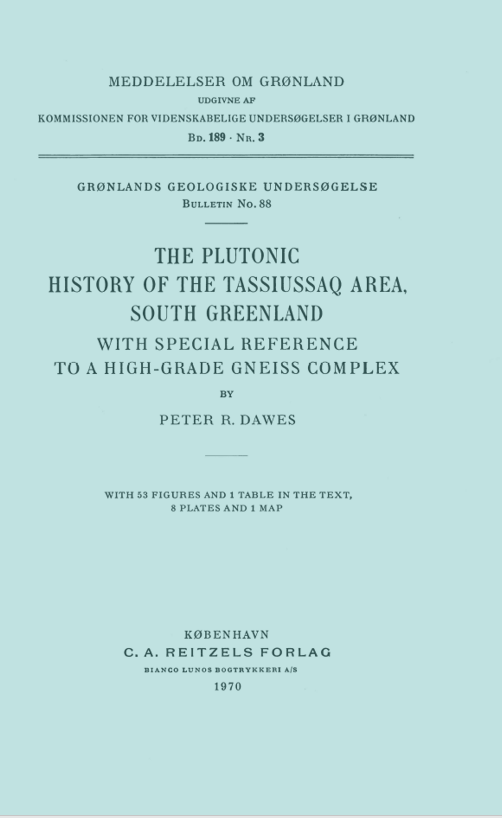The Plutonic History of the Tassiussa Area, South Greenland with Special Reference to a High-Grade Gneiss Complex.
DOI:
https://doi.org/10.7146/mog.v189.150831Abstract
Two Precambrian rock complexes, a high-grade gneiss complex and a younger granitic complex, can be recognised in the Tasiussaq area of South Greenland. Both complexes are cut by late basic dykes and faults. The high-grade gneiss complex is composed of a variety of gneisses and granites, together with small areas of metasediments and metavolcanic rocks displaying well-preserved primary structures. Basic and ultramafic rocks also occur. Basic granulite layers in the gneisses represent early basic intrusions while pyroxene-metadolerite dykes represent later post-gneissic intrusions. The complex is charnockitic in nature, the high-grade mineralogy being the result of granulite facies regional metamorphism. Hypersthene and garnet are common minerals but amphibole, mainly a brown hornblende, has a sparse distribution occurring in rocks containing no free quartz. Biotite is common and it occurs in equilibrium with the anhydrous pyroxene in the presence of H2o. Three phases of migmatisation post-dating an early granulite facies metamorphism can be recognised in the complex. This migmatisation was not connected to a regional downgrading of the complex and retrogressive mineral changes are local. Two structural units can be recognised, a lower unit composed of folded and migmatised gneisses and an upper unit composed of relatively undeformed and unmigmatised meta-arkoses and metaconglomerates. Evidence for four phases of deformation exists in the rocks of the lower unit, the most important structures being large-scale recumbent isoclines and nappe-like folds. Discussion on the age of the Tasiussaq complex is given in the light of the geology of the whole of the Tasermiut fjord region. The idea is favoured that the granitic gneisses, gneisses, schists, metasediments and metavolcanics of the region have not all been derived from a single supracrustal pile. The possibilities that the metaarkoses and metaconglomerates might represent cover rocks to older basement gneisses, or that such metasediments may represent syn-orogenic flysch-type deposits laid down on rocks of the same geological cycle, are considered. The granitic complex is composed of granites of four ages. Hornblende- and biotite-bearing rapakivi granites, which are associated with the intrusion of a suite of dolerite-norite rocks, post-date an autochthonous microcline granite. A late microgranite was emplaced following the potash metasomatism of the rapakivi granites. Diorite, dolerite and ultramafic rocks were intruded during the late stages of the
granitic complex. Comments on the nature of the Precambrian evolution conclude the paper. It is suggested that the plutonism which resulted in the formation of the granitic complex is complementary to that forming the high-grade gneiss complex, indicating a tendency for acidic magma generated at depth during the early stages of a developing orogen to rise to higher levels. The late dolerite dykes and faults which cut both complexes are considered as post-plutonic or epeirogenic events.

Downloads
Published
How to Cite
Issue
Section
License
Coypyright by the authors and the Commision for Scientific Research in Greenland. No parts of the publications may be reproduced in any form without the written permission by the copyright owners.

